November is National Child Safety & Protection Month, and that means it’s time to take a closer look at the physical safety measures that protect kids in and around water.
Even the most attentive adult can’t watch every second — that’s why layers of protection, like pool fences, self-latching gates, and life jackets, are so important. These tools create crucial backup defenses that can prevent tragedies and give families peace of mind.
This month, SwimTopia is helping swim families double-check their surroundings and remember: barriers and safety gear save lives.
Layers of Protection Save Lives
Supervision is vital, but no one can watch every second — that’s why barriers and safety gear provide essential backup protection. Every layer matters. When multiple safety measures work together, you greatly reduce the risk of drowning and keep kids safer around all types of water.
Think of barriers and safety tools as your “second set of eyes.” They can’t replace supervision, but they buy you precious time if something goes wrong.
Secure Pools and Backyards
A properly installed pool fence with a self-closing, self-latching gate is one of the most effective ways to prevent accidents. The U.S. Consumer Product Safety Commission recommends barriers that:
- Are at least four feet high
- Completely surround the pool on all sides
- Have gates that lock automatically
- Leave no gaps children can crawl through or climb over
If your home has a pool or spa, consider door alarms and pool covers for an extra layer of protection. And don’t forget to remove ladders or toys that can attract a curious child’s attention.
💡 SwimTopia Tip: Many SwimTopia teams encourage families to share backyard safety checklists before summer begins — a simple reminder can help protect the entire swim community.
Life Jackets Save Lives — Floaties Don’t
When it comes to open water—lakes, rivers, or oceans—life jackets are non-negotiable. They keep kids buoyant and visible, even in strong currents or unexpected waves. Choose U.S. Coast Guard–approved life jackets that fit snugly, with all straps fastened.
By contrast, inflatable arm bands (“floaties”) or pool noodles are not safety devices. They can slip off, deflate, or create a false sense of security. Always treat these items as toys — never as life-saving gear.
💡 SwimTopia Tip: Teach kids early that wearing a life jacket isn’t optional — it’s what smart swimmers do. Make it part of your team or family routine before every open-water outing.
Safety Beyond the Backyard
Water safety gear matters everywhere — not just at home. Whether it’s a family beach day or swim team travel meet, keep these essentials in your bag:
- A cell phone for emergencies
- Coast Guard–approved life jackets for kids under 13
- A fully stocked first aid kit
- A whistle or alert device
- Sunscreen and water shoes for protection and grip
The Bottom Line
Barriers and safety gear don’t replace supervision — they reinforce it. Together, they form a powerful defense that helps prevent tragedies and gives families peace of mind.
Safe swimmers start with safe surroundings.
Build layers of protection. Use the right gear. Never rely on floaties.
This National Child Safety & Protection Month, take a moment to double-check your barriers, refresh your gear, and share this post with another parent. The more we prepare, the safer our swim communities become.
Part of the SwimTopia Water Safety Awareness Series — empowering swim families with safety tips, confidence, and community.
- Part 1: Watchful Eyes Save Lives: Water Safety Tips for Families
- Part 2: Teach Swimming & Water Basics: 5 Simple Skills That Save Lives
- Part 3: Use Barriers & Safety Gear: Build Layers of Water Protection
- Part 4: Check for Water Hazards: Keep Kids Safe Everywhere
Published 11/16/2025. To see how SwimTopia can help your team, school, or league save time and operate efficiently, visit www.SwimTopia.com to learn more about our Swim Team and Meet Management Software.



